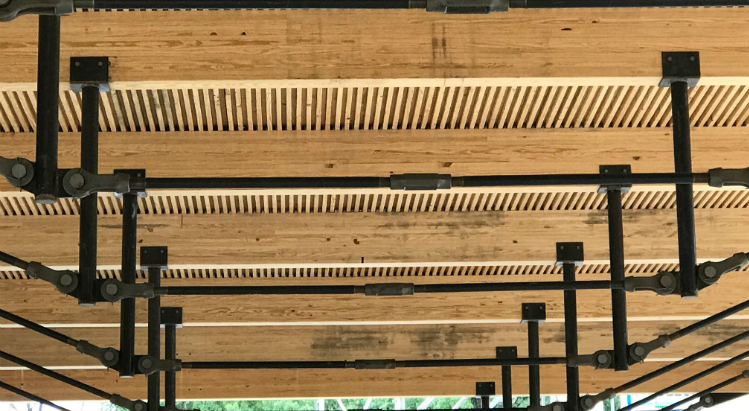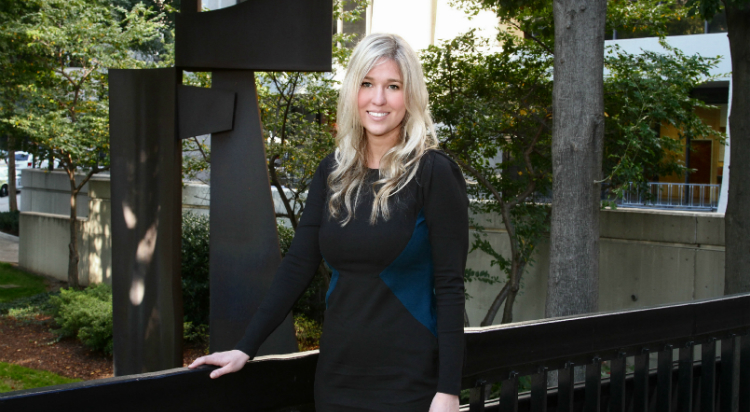If you hear Kelly Roberts speak about whole building lifecycle analysis, you’ll know she’s passionate about the urgency of a specific problem: We had better reduce the amount of embodied carbon in buildings. And we’d better do that soon.
In twelve years at Walter P. Moore’s Atlanta office, Roberts has risen to the level of principal. She also heads up the Sustainable Design Community and Practice for the firm’s Structure Group. In that capacity, she’s responsible for helping one the nation’s largest structural engineering firms adapt to the growing market of owners and designers who are demanding a dramatic reduction in the amount of embodied carbon in buildings.

Roberts is immersed in a small network of engineers, architects, manufacturers, material scientists and data specialists who are grappling with the “embodied carbon” problem. She’s a member of the Structural Engineering Institute’s Sustainability Committee — particularly active in the effort to refine tools that can make carbon reductions more practical. Here in Atlanta, she a founding board member of the Lifecycle Building Center, an organization that’s having a direct impact on embedded carbon. While she didn’t serve on the team that designed the Kendeda Building for Innovative Sustainable Design, she was involved in the process as structural engineer for one of three teams that participated in the ideas competition for the project.
After learning about Roberts’ combination of project experience and knowledge of the issues, I wanted to learn more about what drives her commitment and to gain insights on progress with the embodied carbon problem.
What interested you about structural engineering?
It’s in my blood. My father is a structural engineer and my grandfather is an architect. My father and grandfather immigrated from Cuba, and they started a metal building manufacturing firm. … I realized I love structures, and I loved architecture at an early age.
Were you interested in sustainability before engineering or engineering before sustainability?
Engineering definitely first. I didn’t really know anything about sustainability when I grew up or even at Auburn. I really picked it up after I started working for Walter P. Moore. In graduate school, I did a lot of research into cement alternatives but not really for reasons of sustainability. It was mainly about cost and durability. I didn’t realize it at the time, but a deep understanding of the materials sciences is necessary for a deep understanding of the connection between structural engineering and sustainability because it’s only through an understanding for the materials that you can understand how can stretch the materials and use them more efficiently.
Did sustainability suddenly jump out at you at some point?
I don’t know if I had an epiphany. It was a gradual understanding of our impact. The biggest number that stands out to me is learning that cement alone is responsible for 5 to 7 percent of the world’s carbon output. All of a sudden, I started realizing that, “Wow, structural engineers can have a huge impact.”
But I’ve heard you speak, and you also seem passionate about the issue of climate change.
Let me see if I can vocalize where that comes from. It essentially comes down to good stewardship. One of the reasons I got into engineering and loving buildings is because you feel that you can have a lasting positive impact — you’re doing something that will affect society as whole, that will go beyond you. But the thing is that if you’re negatively affecting the environment at the same time that you’re building a wonderful building, then you’re not doing what you’ve set out to do. If we’re leaving the world worse than we came then that building isn’t really having a positive impact. So that’s a problem that I’m lucky enough to be in position to help solve.
To what extent, does one need to balance the imperative to reduce embodied carbon budget for a building against other sustainable values, such as toxins and just waste?
They do sometimes conflict with each other. I think the reason the focus is on carbon is that the science is telling us that if we don’t address the carbon issue, then we’re not going to have much else to protect. But one reason I don’t focus on toxins is that I’m just not that knowledgeable about toxins. But I do draw correlations between carbon and other problems, such as toxins. There’s a lot more that goes into material production — along the entire lifecycle of the product. Unhealthy materials can affect the workers who are producing the materials, as well as the occupants, and then they can become part of a disposal issue. Carbon’s the same way. It can be released during the production phase, then it can have an impact on carbon emissions during the operation of a building and so on. So lifecycle assessment can be a really useful tool.
Have any of your projects provided a catalyst for incorporating sustainability into structural engineering?
I don’t know that there has been a single catalyst project. It’s been a progression. But participating in the [Kendeda Building] ideas competition was an impactful experience because of the way the project was approached. It really was the only project where sustainability and carbon inputs were a design driver from the very start, and where the structural engineer was at the table so early. And I think it made a difference because it really caused the team to make an early decision to rely heavily on wood for the structure. Now, I’m seeing a little bit more interest across the region in mass timber structures. I’m not saying that’s just because of the Kendeda Building. A lot of calls that are coming within the industry are really coming out the increased awareness being brought out by Architecture 2030 and others.
It’s interesting to hear a structural engineer talking about Architecture 2030. But I suppose a global push by architects for carbon neutral buildings would affect your field in a pretty big way.
The thing is that they have a bigger platform than just structural engineers and materials nerds. For a long time, even Architecture 2030 had been focused on operational efficiencies — driving down those EUIs. Then, all of sudden mostly [Architecture 2030 founder] Ed Mazria realized, “Oh, my gosh, we’re not going to hit our targets if we just focus on operations.” The embodied carbon in buildings as they’re now being built is just enormous. So Architecture 2030 is now putting an emphasis on the materials that go into new buildings.
Is it making substantial enough progress?
We’re not really there yet. We have a strong group of people in the structural industry who are really interested and concerned. But that’s not that common, and so far it’s really only there in the large firms that have someone to focus on this area. It really has not penetrated the mainstream structural engineers.
The fact that we’re not dealing with this more quickly doesn’t compute to me. The rate of building and the type of building that we’re doing does not lead to decarbonizing the building industry by 2050. It does not work out. I feel like as an industry we have blinders on.
But this a problem that ultimately boils down to the owners — especially this issue, because it involves choices that have to be made in the construction or renovation of the building. If there’s never a cost imposed for putting carbon in the atmosphere — a carbon tax of some sort — we probably won’t see it enter the mainstream.
At the same time, the tools for measuring carbon impacts seem to be improving.
The way that we measure this is through whole building lifecycle assessments. The tools are improving. The main whole building lifecycle assessment tools right now are Tally and the Athena Impact Estimator, and Skanska is developing the EC3 calculator.
But another major development is that LEED v4 revamped the materials and resources section and went to a more performance perspective, where you look at the entire buildings — and not just the impact on carbon, but also on multiple health and environmental impacts. It’s a big deal for that to be incorporated into LEED because now there are incentives for owners and contractors that are going through LEED to consider the embodied carbon in their buildings — not just the carbon that will be emitted when the building’s operations.
And finally you have companies like Microsoft, which recently announced that it will use EC3 to track embodied carbon on their huge new campus project.
Even if we make reductions on every single project, though, we won’t really understand the impacts that our reductions are having until we start measuring the impacts on every project. So we have a long way to go. But I strongly believe that all of us could make a difference. There’s no magic bullet. There are a lot of little steps. And I think that all of us could do a lot more immediately. There’s a lot of low-hanging fruit.


